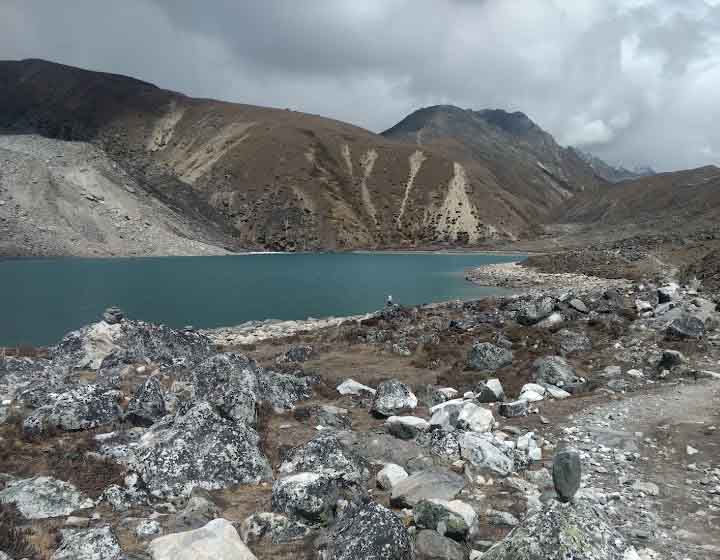
Trip overview
Overview: Gokyo Valley fifth Lake14 14 Days Trekking
The Gokyo Valley Fifth Lake Trek is a stunning alternative to the well-known Everest Base Camp trek. The Gokyo Fifth Lake Trek offers breathtaking views of the world’s highest peaks, turquoise glacial lakes, and the majestic Ngozumpa Glacier—the largest glacier in the Himalayas. Located in Sagarmatha National Park, the Gokyo Fifth Lake trekking provides a quieter and less crowded route, making it ideal for those seeking a perfect blend of nature, culture, and high-altitude adventure.”
Introduction to the Gokyo Lake Trek.
The Gokyo Valley with Fifth Lake trekking takes you deep into the heart of the Khumbu region, where you’ll find six magnificent glacier lakes at elevations ranging from 4,700 to 5,000 meters. The trek begins by following the serene banks of the Dudh Koshi River, gradually leading through traditional Sherpa communities. Along the way, travelers will pass by historic monasteries that echo centuries of culture and spirituality. Furthermore, the journey is adorned with beautiful trees and lush landscapes, creating a picturesque trail. Eventually, after soaking in the rich heritage and natural beauty, trekkers arrive at the breathtaking Gokyo fifth lake, the Gokyo Valley, where stunning glacial lakes and towering peaks await. A notable highlight is the ascent to Gokyo Ri (5,357 m), which provides a panoramic picture of Everest (8,848 m), Lhotse (8,516 m), Makalu (8,485 m), and Cho Oyu (8,188 m).
The Gokyo Valley with Fifth Lake Trekking takes you deep into the heart of the Khumbu region, where six magnificent glacial lakes sit at elevations ranging from 4,700 to 5,000 meters. The journey begins along the serene banks of the Dudh Koshi River, gradually ascending through traditional Sherpa villages rich in culture and history. Along the way, trekkers will pass ancient monasteries, lush landscapes, and picturesque trails that showcase the region’s natural beauty.
The adventure culminates at The Gokyo valley with Fifth Lake, nestled in the stunning Gokyo Valley, surrounded by breathtaking glacial waters and towering Himalayan peaks. A major highlight of this trek is the ascent to Gokyo Ri (5,357 m), offering an unparalleled panoramic view of Everest (8,848 m), Lhotse (8,516 m), Makalu (8,485 m), and Cho Oyu (8,188 m).
Best Time to Trek:
The best time to embark on the Gokyo Fifth Lake trek is during the spring (March to May) and autumn (September to November) seasons. During these months, the weather remains clear, the skies appear vibrant blue, and the views of the snow-capped peaks are at their finest. Moreover, the moderate temperatures and stable conditions make trekking more comfortable and enjoyable. In addition, the trails are adorned with blooming rhododendrons in spring, while autumn offers crisp air and excellent visibility. Therefore, these seasons provide the ideal conditions for an unforgettable trekking experience.
Difficulty Level:
This trek is considered moderate to challenging due to the high altitudes, especially as you ascend towards the Gokyo Valley and Gokyo Ri. Trekkers should be prepared for several days of walking at high altitudes, and acclimatization is crucial to avoid altitude sickness. Previous trekking experience is recommended, but those in good physical condition can certainly complete the trek with proper preparation.
Duration:
The Gokyo Fifth Lake trek typically takes 12 to 14 days to complete, depending on the itinerary and pace. This allows for sufficient acclimatization days and exploration time in the beautiful Gokyo Valley.
This trek is a perfect blend of cultural immersion and high-altitude adventure, making it an unforgettable experience for trekkers seeking both natural wonders and spiritual enrichment.
Peaceful and Less Crowded: In comparison to Gokyo Ri (5,357 m), the trek to Fifth Lake sees significantly fewer visitors. As a result, it offers a quiet and serene experience, making it an ideal choice for trekkers seeking solitude amidst the stunning Himalayan landscape.
Trekking Itinerary Considerations: Many trekkers choose to spend an extra day in Gokyo to explore both the Fourth and Fifth Lakes before continuing their journey toward Gokyo Ri or Cho La Pass. Although this side trip is optional, it is highly rewarding, especially for those trekking along the Everest Base Camp route via Gokyo or Renjo La Pass. By incorporating this excursion, trekkers can enjoy breathtaking views while experiencing the untouched beauty of the region.
Lifestyle of People
The Sherpa people, who are well-known for their hospitality and mountaineering abilities, live largely in the region.
Agriculture and trade include growing potatoes, barley, and vegetables in the summer, as well as herding yaks for dairy products.
Mountaineering and tourism: Many Sherpas serve as guides and porters on trekking and climbing adventures.
Buddhism and Spirituality: Tibetan Buddhism has a profound impact on daily life, with monasteries playing an important role.
Sherpa settlements along the trail, such as Namche Bazaar, Dole, Machhermo, and Gokyo, vividly demonstrate a modest yet tenacious way of life. These villages, deeply rooted in tradition, have adapted remarkably to the severe, high-altitude environment. As trekkers ascend through the region, they witness how the Sherpa people skillfully balance resilience and hospitality, overcoming harsh conditions while preserving their cultural heritage.
Religious and cultural aspects.
Tibetan Buddhism rules the Gokyo region, with gorgeous monasteries, prayer flags, and Mani walls bordering the trekking trails.
The iconic Tengboche Monastery, the largest in the Everest region, serves as a spiritual nexus for both trekkers and locals.
The Gokyo Lakes are revered by both Hindus and Buddhists. Hindu pilgrims think the lakes are the home of Nag Devata (the Serpent God), while Buddhists identify them with Guru Rinpoche (Padmasambhava).
The Janai Purnima event involves Hindu devotees performing rituals and taking holy dips in lakes.
Vegetation and Natural Beauty.
The Gokyo Fifth Lake walk passes across a variety of environments, from lush lowland woods to bleak alpine peaks.
Lower elevations (2,500m to 3,500m): Rhododendron, pine, and birch The forests are home to Himalayan Monals (Nepal’s national bird) and musk deer.
In the middle elevations (3,500 m–4,500 m), juniper bushes and dwarf rhododendrons have replaced the thick woods.
High Altitude (4,500 m+): Rugged glacial terrain with limited vegetation, where hardy plants such as moss and lichens thrive.
Atmosphere and Climate.
Spring (March-May) is ideal for hiking, with sunny skies, blossoming rhododendrons, and mild temps.
Autumn (September–November) is another wonderful season, with crisp mountain views and dependable weather.
Winter (December-February) is harsh and cold, with heavy snow making the journey difficult.
Monsoon season (June–August): During this time, the trails become increasingly slippery and less visible due to heavy rainfall. However, in contrast to lower elevations, the Gokyo region experiences significantly less precipitation during the monsoon season. As a result, trekking conditions tend to be somewhat more favorable despite the occasional rainfall. Furthermore, due to the high altitude, nights remain consistently frigid, often requiring extra layers for warmth. Nevertheless, during the day, when the sun shines brightly, temperatures can rise surprisingly high, creating a stark contrast between the chilly nights and the relatively warm daytime conditions.
Side Trips and Extensions
Hike to Sixth Lake (Gyazumba Tsho) (5,247 m)
Duration: 3-4 hours round trip from Fifth Lake
Why Go? This is the least-visited but incredibly scenic lake in the Gokyo region. It offers a more secluded experience with grand views of Cho Oyu and Everest.
Renjo La Pass (5,360 m)—Alternate Exit Route
Duration: 1 extra day
Why Go? If you don’t want to return via the same route, you can cross Renjo La Pass, which offers jaw-dropping views of Everest, Lhotse, Makalu, and Gokyo Valley.
Route: Instead of returning via Dole, trek from Gokyo to Lungden via Renjo La Pass, then descend to Thame and Namche Bazaar.
Phonak Tsho & Ngozumpa Glacier Exploration
Duration: Half-day from Gokyo
Why Go? Thonak Tsho, the fourth lake, is another beautiful glacial lake beyond Gokyo. The Ngozumpa Glacier, the longest in Nepal, offers a rugged and surreal landscape to explore.
Everest Base Camp & Cho La Pass (5,420m) Extension
Duration: 4-5 extra days
Why Go? If you want the ultimate Everest experience, cross Cho La Pass from Gokyo to join the Everest Base Camp (EBC) trek.
Route: Gokyo → Dragnag → Cho La Pass → Dzongla → Lobuche → Everest Base Camp → Return via Namche.
Hike to Phortse (3,810 m)—Off-The-Beaten-Path Sherpa Village
Duration: 1 extra day
Why Go? Instead of retracing your steps to Namche via Dole, take a scenic detour to Phortse village, home to skilled mountaineers. The trail offers great wildlife spotting (musk deer, Himalayan tahr, pheasants).
Visit Tengboche Monastery (3,867 m)
Duration: 1 extra day (via Phortse or direct from Namche)
Why Go? The largest monastery in the Everest region, Tengboche Monastery, offers spiritual serenity and stunning Everest views.
Khumjung & Kunde Villages (3,790 m)
Duration: Half-day from Namche
Why Go? Explore Khumjung Monastery, home to the legendary Yeti scalp, and visit the Hillary Hospital in Kunde.
Similarly, Himalayan Realms Treks offers a wide range of trekking routes in the Everest region, including both classic trails and off-the-beaten-path adventures. Moreover, these routes cater to trekkers of all skill levels, from beginners seeking a short and scenic trek to experienced hikers looking for a challenging expedition. In addition, the breathtaking landscapes, diverse cultural experiences, and well-established trekking infrastructure make the Annapurna region an ideal destination for adventurers. Below are some of them for your information.
6, Gokyo lake with Renjo-la pass trek
Short Itinerary
Day 01: Arrival in Kathmandu
Day 02: Fly to Lukla - Phakding
Day 03: Namche Bazaar
Day 04: Acclimatization
Day 05: Dole (4,200 m)
Day 06: Trek to Machhermo
Day 07: Trek to Gokyo
Day 08: Acclimatization
Day 09: Trek to Fifth Lake
Day 10: Trek back to Dole
Day 11: Trek to Namche Bazaar
Day 12: Trek to Lukla
Day 13: Fly back to Kathmandu
Day 14: Departure
Itinerary
which takes about 30 minutes. Trek from Lukla to Phakding (2640m.) which is takes approximately three hours. transfer to the domestic airport for your flight to Lukla. Lukla is a small town with an airport. There are few tea shops, lodges, hotels and general stores found around here. You begin today’s trek from Lukla following a gentle climb up the mountainside on the left bank of the Dudh Koshi River. Nupla (5885m) can be seen in the distance on the opposite bank, is a peak atop the Kongde Ridge. You descend a mountainside path that merges into your route to Everest, with views to a valley to your right; and at its far end, Kusum Kang (6367m.) The Dudh Kosi approaches as you pass a Mani wall and arrive at a Ghat teahouse. You continue along a small path with many climbs and descents following the left bank of Dudh Koshi to Phakding. Stay overnight at lodge or camp.
Trek from Phakding to Namche Bazaar (3440 m.) which takes about five hours. This day you trek and cross the river on high suspension bridges. Beyond Monjo (2800m.) is the entrance to the Sagarmatha National Park which was set up in order to protect and preserve this fragile mountain environment. Then ascend quite steeply to Namche Bazaar and along the way, if the weather is clear, catch a first glimpse of Mt Everest in the distance. You can also enjoy the view of Mt. Kusum Kangaru, Thamserku, Konde-Ri and Tawache peak. You will also visit some of the village monasteries on the way of trekking to Namche Bazaar (3440 m.). Namche is the main trading village in the Khumbu region and holds a busy Saturday market. This is a meeting place for the Hindu traders from the lowlands and the Tibetan yak caravans that have reached here by crossing the glaciated Nangpa La, a tradition that has continuously occurred for centuries. Stay overnight at lodge or camp.
Rest at Namche Bazaar for acclimatization and do some excursion around the town.Namche is tucked away between two ridges amidst the giant peaks of the Khumbu and has an abundance of lodges, tea shops and souvenir shops, and also has a magnificent natural outlook. It is an ideal place to spend a rest day for acclimatization at a high altitude before heading off towards Tyangboche. For acclimatization you walk up to Khunde Hospital which was set up by the late Sir Edmund Hillary and you can also hike for an hour up to Tyangboche (3800m.) where Everest View Hotel is situated above Namche for some outstanding views of Everest, Nuptse, Lhotse, Ama Dablam, Thamserku and Kusum Kangaru. There are also good views from the National Park Centre and Museum just above the town. Stay overnight at lodge or camp.
Trek via Khumjung, it takes about six hours. From Namche the route heads up all the way to Khumjung, a picturesque village which also has its own gompa at the top end of town. Here, you can have excellent views of Thamserku, Kantega and Ama Dablam. Soon after leaving Khumjung the trail climbs to a large chorten on top of a ridge. This ridge descends from Khumbila, a 5734m peak, said to be the abode of the patron God of the Khumbu region. The trail descends slightly towards the Sanasa and then trail ascends up to Mongla (4000m.). From here, you can see panoramic views of various mountains. You trek steeply descending the pass through Phortse Tenga and from there, the trail climbs steeply to Dole, through rhododendron and birch forest festooned with hanging mosses and lichens. You can enjoy a delicious meal at Phortse Tenga (3650m.). Stay overnight at lodge or camp.
Trek from Dole to Machhermo which takes about five hours. From Dole you climb steadily along the side of the valley, where small and thorny bushes give way to scrub juniper as the altitude increases. The trail passes many summer settlements, which are used when yaks are taken to these pastures to graze in the summer months. Ahead of you are excellent views of Cho Oyu, while back down the valley are the peaks of Kantega and Thamserku. This is a short day and you will arrive at Machhermo in time for lunch. Stay overnight at lodge or camp.
Trek from Machhermo to Gokyo which takes about four and half hours. Today you head for the lakes at Gokyo. You follow a very scenic path to Pangka and then descend slightly, following one of the melted-water Rivers which flow down the west side of the Ngozumpa Glacier. You climb a steep rocky incline into the valley by the side of the glacier, passing the first of the holy lakes. You soon arrive at the second of the lakes, crossing the path which heads across the glacier to Cho La (5420m.), your route to Lobuche and Everest and later in the trek. The third lake is known as Dudh Pokhari and on its eastern shore is the settlement of Gokyo. Walking by the side of the lake, the scenery is magnificent with the summits of Cho Oyu and Gyachung Kang reflected in its emerald green waters. Stay overnight at lodge or camp.
This is the best acclimatization hike, offering breathtaking panoramic views of Everest (8,848m), Lhotse (8,516m), Makalu (8,485m), Cho Oyu (8,188m), and the Gokyo Lakes.
The hike takes about 3–4 hours round trip.
Gokyo (4,790m) to Fourth Lake (Thonak Tsho - 5,000m) The trail follows the lateral moraine of the Ngozumpa Glacier with a gradual ascent.It takes 1–1.5 hours to reach the Fourth Lake (Thonak Tsho), a deep blue glacial lake surrounded by rocky terrain. From the fourth lake, continue for another 45 minutes to 1 hour to reach the Fifth Lake (Ngozumpa Tsho). The lake is bigger and offers breathtaking views of Everest, Lhotse, Nuptse, Makalu, Cho Oyu, and the massive Ngozumpa Glacier. Just 10–15 minutes beyond Fifth Lake, this view point provides one of the best views of Everest and the north face of Cho Oyu. After enjoying the views, retrace your steps back to Gokyo. Stay overnight in Gokyo.
Trek/climb from Gokyo to Gokyo Ri (5483m) and trek back to Machhermo (4150m.) via.Gokyo village and this takes about four and half hours. Gokyo Ri looms above the village on the northern edge of the lake and you leave camp just after first light, following a steep path up the hillside. As you climb, the summits of Everest, Lhotse and Makalu slowly come into sight and the view from the summit of Gokyo Ri itself, is one of the finest to be had in the Everest region – some say it is even better than that from Kala Patthar. After lunch it is a short walk to the village of Machhermo. Stay overnight at lodge
Trek from Machhermo (4150m.) to Namche Bazaar (3440m.) which takes about five hours. The trail gently descends to Dole and then starts descending steeply to Photse Tenga (3650m.) passing through rhododendron forests. Then, the path immediately ascends steeply to Mongla Danda (4000m.) and gently descends up to Kyanjoma (3500m.) following small up and down trail to your next destination. Stay overnight at lodge or camp.
Trek from Namche Bazaar to Phakding (2600 m.) which takes about 4 hours. Trek leads from Namche Bazaar via. Monjo to Phakding. The trek is pleasant, except for a few short uphill climbs and then down to the Bhote-Koshi River crossing it fifth times. will bring you to Phakding for your overnight stay Stay overnight at lodge.
After breakfast trek back to same toute to Lukla about 3 hrs. The last uphill climb of 45 minutes will bring you to Lukla for your overnight stay. Stay over night at lodge,
Fly from Lukla to Kathmandu which takes 30 minutes. You take an early morning flight back to Kathmandu
Final departure on your destination.
Included
- All airport and hotel transfers
- 2-night hotel in Kathmandu with B/B plan
- National Park permit & Pasang Lhambu village entry permit
- Flight fare from Kathmandu-Lukla-Kathmandu
- Accommodation in the tea house, During the trek
- Food:- Breakfast, Lunch, Dinner and Tea/coffee during trek.
- Guide: – including salary, insurance, equipment, flight, food and lodging
- Porter: – including salary, insurance, equipment, food and lodging.
- For guest: -Down jacket, Good sleeping bag (down jacket and sleeping bag are to be returned after trip completion).
- Transfer from airport to hotel in Kathmandu
- All government and local taxes.
- Final departure from hotel to international airport transfer.
Not Included
- Food in Kathmandu ( Lunch & Dinner).
- Bakery food during the trek.
- Nepal Visa fee.
- International airfare.
- Extra night accommodation in Kathmandu
- Travel and rescue insurance if guest get mountain sickness and need to rescue helicopter.
- Personal expenses example (phone calls, laundry service , bar bills, battery recharge, WIFI charge, extra porters, bottle water or boiled water, shower etc.)
- Tips for guide and porters
Join Us Upcoming Trips
Book this trip with us. Here are the upcoming dates. Feel free to share this trip with your friends and family. For custom trips or general inquiries contact us.
| Departure Date | Trip Duration | Price | Status | |
|---|---|---|---|---|
| 01 October, 2025 | 14 days | $2150 | Fixed departure | |
| 15 October, 2025 | 14 days | $2150 | Fixed departure | |
| 22 October, 2025 | 14 days | $2150 | Fixed departure | |
| 05 November, 2025 | 14 days | $2150 | Fixed departure | |
| 15 November, 2025 | 14 days | $2150 | Fixed departure | |
| 25 November, 2025 | 14 days | $2150 | Fixed departure | |
| 02 December, 2025 | 14 days | $2150 | Fixed departure | |
| 15 December, 2025 | 14 days | $2150 | Fixed departure |
Useful Info
Fitness & Preparation
Physical Training: cardiovascular endurance, leg strength, and altitude adaptation.
Recommended Training: Hiking, running, and strength training for at least 6-8 weeks.
Mental Preparation: Long trekking days at high altitude require stamina and resilience.
Packing List
Clothing:
Insulated down jacket
Waterproof & windproof jacket
Base layers (moisture-wicking)
Fleece jacket/pullover
Trekking pants (convertible)
Thermal gloves & socks
Sun hat & woolen beanie
Gear:
Sleeping bag (-10°C to -15°C)
Trekking poles
Sunglasses (UV protection)
Headlamp with extra batteries
Footwear:
High-quality trekking boots (waterproof)
Comfortable camp shoes
Essentials:
Sunscreen (SPF 50) & lip balm
First aid kit (altitude sickness meds, pain relievers, bandages)
Water bottles & purification tablets
Accommodation & Food
Accommodation: Basic teahouses with twin-sharing rooms.
Food Options: Dal Bhat, noodles, soups, Tibetan bread, momos, eggs, and tea.
Drinking Water: Boiled water, purification tablets, or bottled water (avoid plastic waste).
Altitude Sickness & Safety
Symptoms: headache, dizziness, nausea, breathlessness.
Prevention: Acclimatization days; hydrate well; ascend gradually.
Emergency Measures: Descend if symptoms persist; carry Diamox (consult a doctor).
Best Time for the Gokyo Fifth Lake Trek
Spring (March-May): clear skies, blooming rhododendrons, moderate temperatures.
Autumn (Sept-Nov): stable weather, excellent visibility, peak trekking season.
Avoid monsoon (June-August) and winter (Dec-Feb) due to heavy rain/snow.
Why Choose Gokyo Fifth Lake Trek?
Less crowded alternative to Everest Base Camp
Stunning Gokyo Lakes & glacier views
Unique perspective of Everest & surrounding peaks
Experience Sherpa culture & lifestyle
FAQs
-
How difficult Gokyo valley and Fifth lake?
The trek to Fifth Lake is a rewarding challenge for experienced trekkers or those who are well-acclimatized. If you have already reached Gokyo Ri (5,357m) without major altitude issues, the Fifth Lake trek should be manageable with proper pacing.
-
If we get mountain sickness in the fifth lake what cha we do ?
If symptoms worsen or don't improve after descent, arrange helicopter rescue to Kathmandu or a lower medical facility.
-
What is the maximum altitude reached?
The highest point of this trek is Gokyo Ri (5,357m/17,575ft), which provides panoramic views of the Himalayas. The Fifth Lake is at an altitude of around 5,100m (16,732ft).
-
What is the best season for this trek?
Spring (March–May) – Clear skies, rhododendron blooms, and moderate temperatures. Autumn (September–November) – Best visibility, stable weather, and comfortable trekking conditions.
-
Do I need a permit for the trek?
Yes, you need: Sagarmatha National Park Entry Permit. Khumbu Pasang Lhamu Rural Municipality Permit
-
What kind of accommodation is available?
Lodges and teahouses provide basic but comfortable accommodation along the route. Some offer attached bathrooms in lower altitudes, while higher altitudes have more basic facilities.
-
What kind of food is available?
Typical Nepali and Tibetan meals, along with continental options like pasta, noodles, soups, and eggs, are available. Dal Bhat (rice and lentils) is a popular energy-rich meal among trekkers.
-
How do I get to the starting point of the trek?
Most trekkers fly from Kathmandu to Lukla (about 35 minutes) and start trekking from there.
-
Most trekkers fly from Kathmandu to Lukla (about 35 minutes) and start trekking from there.
Fifth Lake offers magnificent views of Mount Everest, Cho Oyu, Nuptse, Lhotse, and the vast Ngozumpa Glacier, making it a must-visit for those seeking a less-crowded experience in the Everest region.
-
Can I charge my electronic devices?
Yes, but charging facilities are limited and may require an extra fee. Bringing a power bank is advised.
-
Is internet and mobile network available?
Yes, Wi-Fi is available in some teahouses for a fee, and NTC/Ncell networks work in certain areas, but the connection can be weak or unreliable.
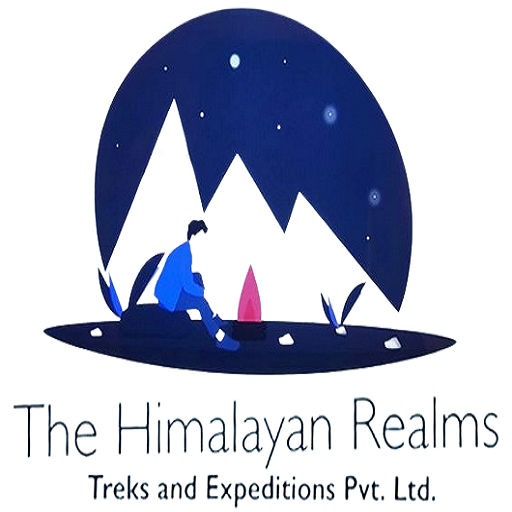


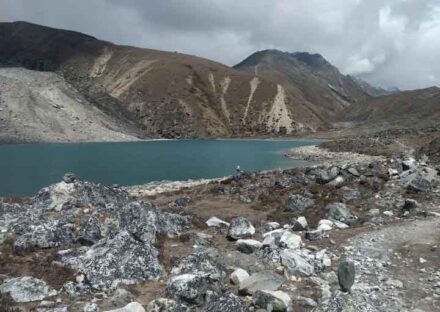
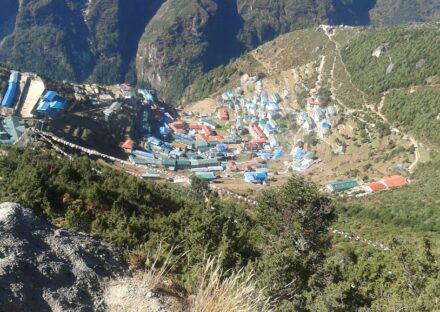
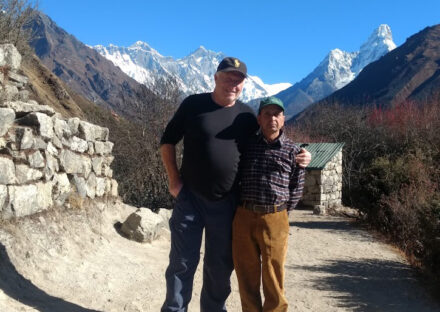
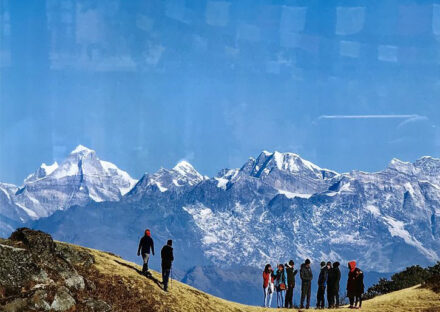
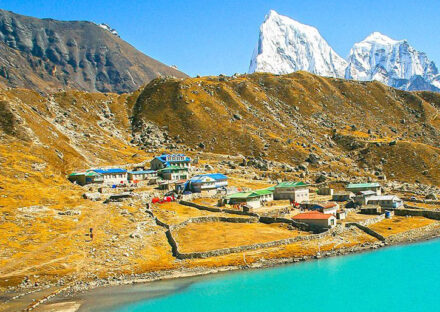
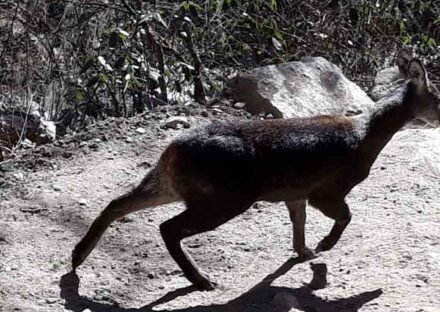
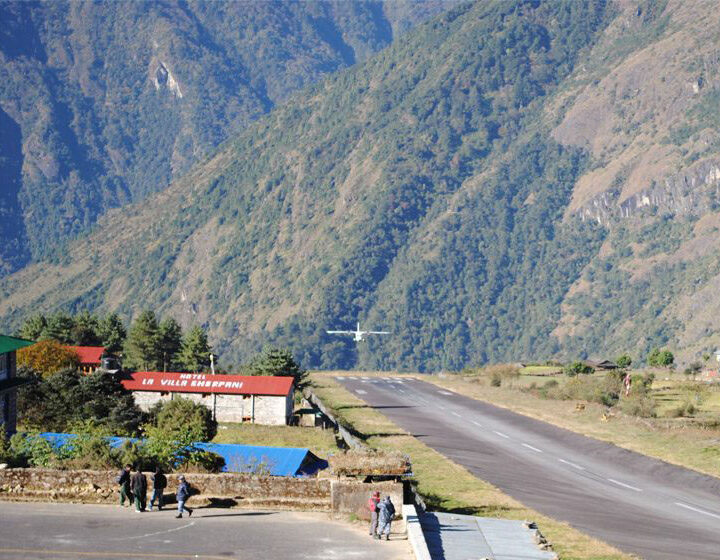
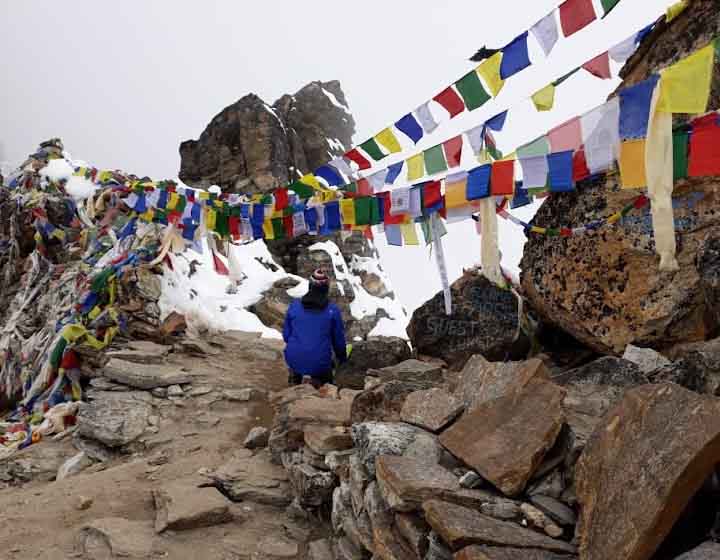
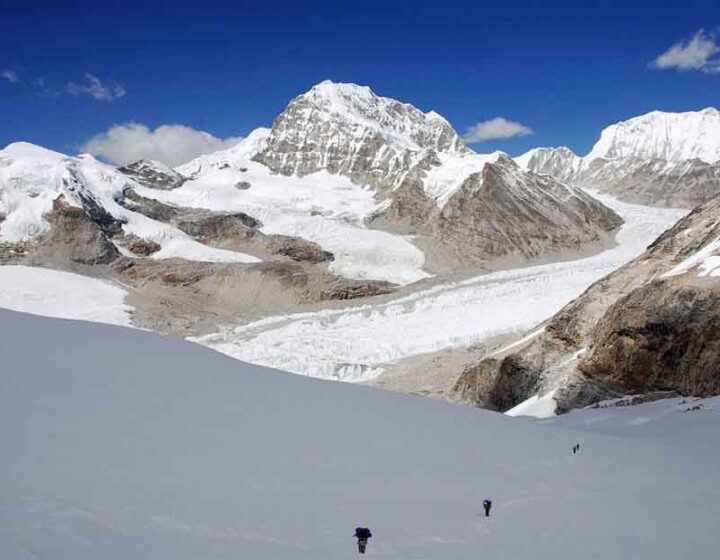
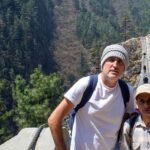
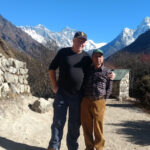
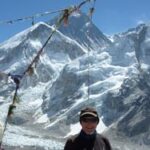
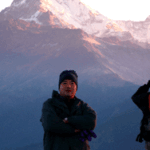
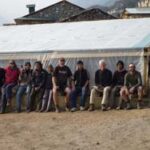
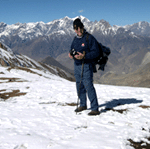
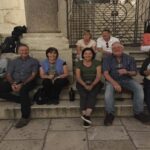
Leave a Review